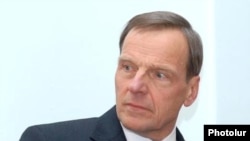Testifying before a key committee of the European Parliament, Robert Bradtke, the U.S. co-chair of the OSCE Minsk Group, reiterated international mediators’ hopes that the Armenian and Azerbaijani presidents will reach a framework agreement at their upcoming meeting in Kazan, Russia.
“As we move from this stage of the process -- from negotiations to agreement, to implementation -- I think there will be more room for all countries to do more, to have a larger role in supporting the peace process. And I think that’s certainly true for the European Union,” he said.
“As we move into the implementation phase, there will be a continuum of actions ranging from confidence-building measures, person-to-person contacts, dialogue between the sides to the harder-edged issues, that would come at the end of the process, of resettlement, reconstruction. Those are all issues that I think the European Union will have a significant role in as the time comes,” added Bradtke.
Bradtke’s French opposite number, Bernard Fassier, likewise stressed the EU’s “absolutely decisive” role in the next stages of the peace process as he spoke during hearings on the Karabakh dispute organized by the European Parliament’s Committee on Foreign Affairs.
Bradtke, Fassier and the Minsk Group’s third co-chair, Igor Popov of Russia, toured the conflict zone last week to discuss preparations for the Kazan summit tentatively scheduled for June 25. The visit was followed by a meeting of the Armenian, Azerbaijani and Russian foreign ministers in Moscow.
Official Baku and Yerevan said afterwards that the conflicting parties significantly narrowed their differences on the basic principles of a Karabakh settlement proposed by the mediating powers.
According to Fassier, the mediators expect the parties to “consolidate the progress in a written form in the nearest future.”
The basic principles were first formally presented to Armenia and Azerbaijan in Madrid in late 2007. They have has since undergone several modifications aimed at making them more acceptable to both sides.
The document calls for a gradual settlement that would start with the liberation of Azerbaijani districts around Karabakh that were occupied by Karabakh Armenian forces during the 1991-1994 war. In return, the dispute territory’s predominantly Armenian population would be able to determine its final status in a future referendum.
The conflicting parties have disagreed on some crucial details of this peace framework, which are still not made public by the mediators. Bradke and Fassier refused to elaborate on them during the hearings.
But the French negotiator did specify that the Madrid document was “4-5 pages long” and contained 14 concrete principles. “This was welcomed in early 2008 by both sides,” he told EU lawmakers. “Unfortunately, the international recognition of the independence of Kosovo made Azerbaijan anxious and during the whole year 2008 we had difficulties with Azerbaijan. But in 2009 we made a lot of progress and we thought we were about to reach a breakthrough.”
Fassier said the breakthrough did not materialize because Armenia rejected a modified version of the basic principles in early 2010. He added that chances of an Armenian-Azerbaijani peace deal again increased after Presidents Serzh Sarkisian and Ilham Aliyev made “some progress” at their last meeting held in the Russian city of Sochi last March.
Foreign Minister Edward Nalbandian said last week that the latest version of the basic principles discussed at Sochi is largely acceptable to the Armenian side.




